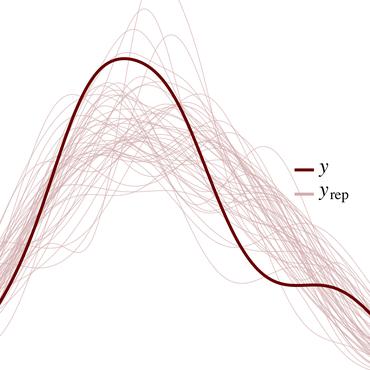Search Results for author: Maxim Borisyak
Found 14 papers, 4 papers with code
Data Augmentation Scheme for Raman Spectra with Highly Correlated Annotations
no code implementations • 1 Feb 2024 • Christoph Lange, Isabel Thiele, Lara Santolin, Sebastian L. Riedel, Maxim Borisyak, Peter Neubauer, M. Nicolas Cruz Bournazou
This is of interest in scenarios where large amounts of historical data are available but are currently not used for model training.
Latent State Space Extension for interpretable hybrid mechanistic models
no code implementations • 6 Dec 2023 • Judit Aizpuru, Maxim Borisyak, Peter Neubauer, M. Nicolas Cruz Bournazou
We demonstrate the framework's capabilities by fitting a hybrid model based on a simple mechanistic growth model for E. coli with data generated in-silico by a much more complex one and identifying missing kinetics.
Deep Learning for Fast Inference of Mechanistic Models' Parameters
no code implementations • 5 Dec 2023 • Maxim Borisyak, Stefan Born, Peter Neubauer, Mariano Nicolas Cruz-Bournazou
We consider a training procedure that combines Neural Networks and mechanistic models.
Deep Set Neural Networks for forecasting asynchronous bioprocess timeseries
no code implementations • 4 Dec 2023 • Maxim Borisyak, Stefan Born, Peter Neubauer, Mariano Nicolas Cruz-Bournazou
The method is agnostic to the particular nature of the time series and can be adapted for any task, for example, online monitoring, predictive control, design of experiments, etc.
When Bioprocess Engineering Meets Machine Learning: A Survey from the Perspective of Automated Bioprocess Development
no code implementations • 2 Sep 2022 • Nghia Duong-Trung, Stefan Born, Jong Woo Kim, Marie-Therese Schermeyer, Katharina Paulick, Maxim Borisyak, Mariano Nicolas Cruz-Bournazou, Thorben Werner, Randolf Scholz, Lars Schmidt-Thieme, Peter Neubauer, Ernesto Martinez
ML can be seen as a set of tools that contribute to the automation of the whole experimental cycle, including model building and practical planning, thus allowing human experts to focus on the more demanding and overarching cognitive tasks.
NFAD: Fixing anomaly detection using normalizing flows
1 code implementation • 19 Dec 2019 • Artem Ryzhikov, Maxim Borisyak, Andrey Ustyuzhanin, Denis Derkach
Most of the conventional approaches to anomaly detection, such as one-class SVM and Robust Auto-Encoder, are one-class classification methods, i. e. focus on separating normal data from the rest of the space.
Adaptive Divergence for Rapid Adversarial Optimization
1 code implementation • 1 Dec 2019 • Maxim Borisyak, Tatiana Gaintseva, Andrey Ustyuzhanin
Adversarial Optimization (AO) provides a reliable, practical way to match two implicitly defined distributions, one of which is usually represented by a sample of real data, and the other is defined by a generator.
Machine Learning on sWeighted Data
no code implementations • 17 Oct 2019 • Maxim Borisyak, Nikita Kazeev
Data analysis in high energy physics has to deal with data samples produced from different sources.
$(1 + \varepsilon)$-class Classification: an Anomaly Detection Method for Highly Imbalanced or Incomplete Data Sets
1 code implementation • 14 Jun 2019 • Maxim Borisyak, Artem Ryzhikov, Andrey Ustyuzhanin, Denis Derkach, Fedor Ratnikov, Olga Mineeva
We explore a novel method that gives a trade-off possibility between one-class and two-class approaches, and leads to a better performance on anomaly detection problems with small or non-representative anomalous samples.
Machine Learning on data with sPlot background subtraction
1 code implementation • 28 May 2019 • Maxim Borisyak, Nikita Kazeev
In this paper we propose a mathematically rigorous way to train machine learning algorithms on data samples with background described by sPlot to obtain signal probabilities conditioned on observables, without encountering negative event weight at all.
Numerical optimization for Artificial Retina Algorithm
no code implementations • 25 Sep 2017 • Maxim Borisyak, Andrey Ustyuzhanin, Denis Derkach, Mikhail Belous
High-energy physics experiments rely on reconstruction of the trajectories of particles produced at the interaction point.
Muon Trigger for Mobile Phones
no code implementations • 25 Sep 2017 • Maxim Borisyak, Michail Usvyatsov, Michael Mulhearn, Chase Shimmin, Andrey Ustyuzhanin
The CRAYFIS experiment proposes to use privately owned mobile phones as a ground detector array for Ultra High Energy Cosmic Rays.
Towards automation of data quality system for CERN CMS experiment
no code implementations • 25 Sep 2017 • Maxim Borisyak, Fedor Ratnikov, Denis Derkach, Andrey Ustyuzhanin
Daily operation of a large-scale experiment is a challenging task, particularly from perspectives of routine monitoring of quality for data being taken.
A genetic algorithm for autonomous navigation in partially observable domain
no code implementations • 27 Jul 2015 • Maxim Borisyak, Andrey Ustyuzhanin
The problem of autonomous navigation is one of the basic problems for robotics.







